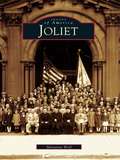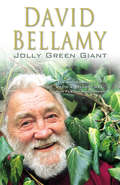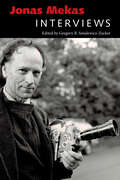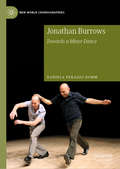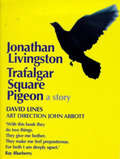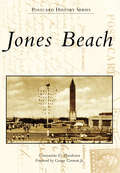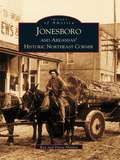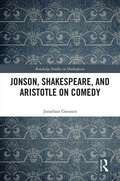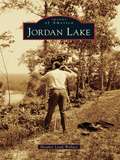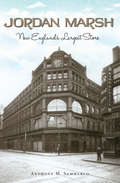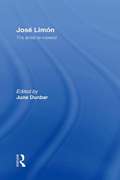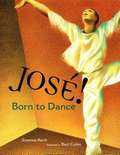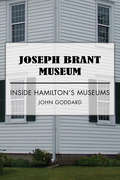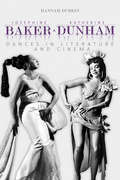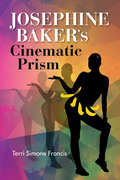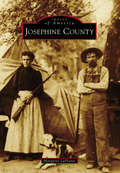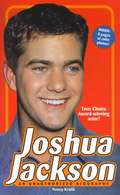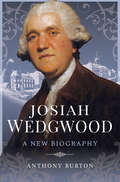- Table View
- List View
Joliet (Images of America)
by Marianne WolfJoliet once was a lush prairie bordered with scenic bluffs along the Des Plaines River. In the late 19th century, settlers and a large influx of Eastern European immigrants arrived, transforming the area into a bustling industrial community of steel, limestone, manufacturing, and transportation. In the 20th century, Joliet transformed itself from an industrial hub to a destination of entertainment and tourism. Tourism thrives as people visit the National Hot Rod Association drag strip, NASCAR track, two casinos, the JackHammers minor-league baseball team and baseball stadium, a water park, the historical museum, and library. Joliet depicts the rich cultural heritage impressed on the city and shows how the people lived and worked together, earning Joliet the title of All-American City in 1955 by the National Municipal League and Look magazine.
Jolly Green Giant
by David BellamyDavid Bellamy is a natural story teller whose memoir will be packed full of funny anecdotes and observations. It is the story of how a city boy, brought up in the middle of London, went for a trip into the countryside one day, an event which was to transform his life by setting in motion the amazing love of nature which would make famous this larger-than-life character. In his infectious style he illumines on, amongst other things, the fact that his father, the manager of a branch of Boots, had to grease his hair straight - because in those days managers of Boots weren't allowed to have curly hair! Then there was the time he and his brother discovered an exploded bomb, kept in the garden shed - and then accidentally blew off the front of the house with it. He reveals his secret passion is ballet dancing - and how his mother only found out about it when she saw him on stage at the Fairfield Hall in Croydon. His career as an academic, then author, broadcaster, consultant and television personality, spans 35 years and his main passion - campaigning for the environment - have led to many adventures including his being twice imprisoned in the Third World.
Jon Brooks: Art from Nature (Fountas & Pinnell LLI Gold #Level T)
by Susan BuckleyJon Brooks: Art from Nature Author: Susan Buckley
Jonas Mekas: Interviews (Conversations with Filmmakers Series)
by Gregory R. Smulewicz-ZuckerA refugee from post–World War II Europe who immigrated to the US in 1949, Jonas Mekas (1922–2019) became one of America's foremost champions of independent cinema and one of its most innovative filmmakers. An admired poet in his native Lithuania, Mekas began recording his life on film shortly after his arrival in New York. Through his work as the author of the Village Voice’s “Movie Journal” column, editor of Film Culture magazine, and founder of Anthology Film Archives and the Film-Makers’ Cooperative, Mekas played a vital role in the promotion of avant-garde and independent films. His early films, Guns of the Trees and The Brig, challenged the structure of traditional narrative filmmaking. He is best known for his “diary films,” including Walden (Diaries, Notes, and Sketches); Reminiscences of a Journey to Lithuania; and As I Was Moving Ahead Occasionally I Saw Brief Glimpses of Beauty. His films, writings, and the institutions he built have influenced generations of filmmakers, poets, artists, musicians, critics, and scholars. In Jonas Mekas: Interviews, volume editor Gregory R. Smulewicz-Zucker collects eighteen interviews covering almost sixty years of the filmmaker’s career. Mekas discusses his remarkable life as a refugee from Nazi- and Soviet-occupied Lithuania, his role as one of the major figures in the development of the American avant-garde, and his thoughts about his own work. In conversation with scholars, journalists, and other prominent artists, Mekas speaks of his passion for artistic expression and uncompromising vision for a liberated cinema. These interviews preserve Mekas’s voice so that it might speak to future generations of artists and intellectuals.
Jonathan Burrows: Towards a Minor Dance (New World Choreographies)
by Daniela Perazzo DommThe first monograph on the work of British choreographer Jonathan Burrows, this book examines his artistic practice and poetics as articulated through his choreographic works, his writings and his contributions to current performance debates. It considers the contexts, principles and modalities of his choreography, from his early pieces in the 1980s to his latest collaborative projects, providing detailed analyses of his dances and reflecting on his unique choreomusical partnership with composer Matteo Fargion.Known for its emphasis on gesture and humour, and characterised by compositional clarity and rhythmical patterns, Burrows’ artistic work takes the language of choreography to its limits and engages in a paradoxical, and hence transformative, relationship with dance’s historical and normative structures. Exploring the ways in which Burrows and Fargion’s poetics articulates movement, performative presence and the collaborative process in a ‘minor’ register, this study conceptualises the work as a politically compelling practice that destabilises major traditions from a minoritarian position.
Jonathan Livingston Trafalgar Square Pigeon
by David LinesContinuing the tradition of parodying all things sacred, the author of The XXXX Files and PMT takes up the reigns of satire by rewriting the essential 1970s hippy handbook Jonathan Livingston Seagull. Instead of a seagull for a hero, this updated classic features a bloated, cynical, grungy pigeon, who looks not to the skies for inspiration, but to the London Underground. Cutting corners wherever possible and living the life of a fully fledged MTV-generation feral pigeon, Jonathan's rite of passage is more a celebration of modern-day teenage apathy set against a backdrop of 90s Pop Culture and Victorian underground architecture than a voyage of delicious self-discovery. Matching the original page-for-page in content and layout, Jonathan Livingston Trafalgar Square Pigeon is a modern-day morality tale that will, by its very nature, attract plenty of attention whilst ever so gently ruffling a few feathers along the way.
Jonathan Swift and the Eighteenth-Century Book
by Paddy Bullard James MclavertyJonathan Swift lived through a period of turbulence and innovation in the evolution of the book. His publications, perhaps more than those of any other single author, illustrate the range of developments that transformed print culture during the early Enlightenment. Swift was a prolific author and a frequent visitor at the printing house, and he wrote as critic and satirist about the nature of text. The shifting moods of irony, complicity and indignation that characterise his dealings with the book trade add a layer of complexity to the bibliographic record of his published works. The essays collected here offer the first comprehensive, integrated survey of that record. They shed new light on the politics of the eighteenth-century book trade, on Swift's innovations as a maker of books, on the habits and opinions revealed by his commentary on printed texts and on the re-shaping of the Swiftian book after his death.
Jones Beach (Postcard History Series)
by Constantine E. Theodosiou George Gorman Jr.Envisioning a noble beachfront park so ordinary people could enjoy a slice of the good life, master builder Robert Moses set out to transform a little-known barrier island off Long Island's South Shore into the civic masterpiece now known as Jones Beach State Park. All vacationers and day-trippers had to do was simply follow its beloved mascot, the Jones Beach seahorse, for an unforgettable day of sand and surf, or for a swim in the saltwater pool at the West Bathhouse, a stroll along the boardwalk, or a friendly match of shuffleboard, pitch-putt golf, or archery. The Indian Village also awaited, as well as fine dining at the Boardwalk Restaurant, a musical at the Marine Theatre, or a night of dancing to the songs of Guy Lombardo.
Jonesboro and Arkansas's Historic Northeast Corner (Images of America)
by Ray Hanley Diane HanleyWhen Union soldiers returned North after the Civil War, they brought home stories of a sparsely populated area with bountiful timber and potential for homes and farms. Over the next 50 years, first by wagon train and then by railroads, settlers came to build not only homes and farms but also thriving communities in the Clay, Greene, and Craighead counties of northeastern Arkansas. Today, visitors and residents of the area see the bustle of Jonesboro and the thriving Arkansas State University. Readers of Jonesboro and Arkansas' Historic Northeast Corner will discover Jonesboro as it lived a century ago, a promising town of 7,000 citizens. As the 20th Century opened, modern and attractive towns such as Corning, Piggott, Rector, and Paragould began to thrive. The evolution of these historic areas-from slow-paced villages with dirt roads and horse-drawn wagons to the bustling towns of the late 20th century-is chronicled in this Images of America edition.
Jonesborough (Images of America)
by Sonya A. HaskinsOriginally established in 1779 as the seat of Washington County, North Carolina, Jonesborough is the oldest incorporated town in Tennessee. Early pioneers were given land grants to settle west of the mountains, but by 1784, they no longer trusted their political leaders in North Carolina. They created their own local government and established the state of Franklin, naming Jonesborough the original capital of the "lost" 14th state. Never recognized by Congress, Franklin eventually fizzled out and Tennessee was formed. Although Tennessee was a slave-holding state prior to the Civil War, Jonesborough produced the earliest regularly published periodical devoted to abolishing slavery. Today, Jonesborough is listed on the National Register of Historic Places, with many buildings fully restored. In this volume, readers will see the Christopher Taylor House, which was built about 1778, and the Chester Inn, which hosted many famous guests in its original days, including Presidents Andrew Jackson, Andrew Johnson, and James K. Polk.
Jonson, Shakespeare, and Aristotle on Comedy (Routledge Studies in Shakespeare)
by Jonathan GoossenJonson, Shakespeare, and Aristotle on Comedy relates new understandings of Aristotle’s dramatic theory to the comedy of Ben Jonson and William Shakespeare. Typically, scholars of Renaissance drama have treated Aristotle’s theory only as a possible historical influence on Jonson’s and Shakespeare’s drama, focusing primarily on their tragedies. Yet recent classical scholarship has undone important misconceptions about Aristotle’s Poetics held by early modern commentators and fleshed out the theory of comedy latent within it. By first synthesizing these developments and then treating them as an interpretive theory, rather than simply an historical influence, this book demonstrates a remarkable consonance between Aristotelian principles of plot and its emotional effect, on the one hand, and the comedy of Shakespeare and Jonson, on the other. In doing so, it also reveals surprising similarities between these seemingly divergent dramatists.
Jordan Lake
by Heather Leigh WallaceIn 1945, Hurricane 9 rocked the Carolinas, severely flooding and incapacitating the New Hope Valley area. As a result, Congress directed the U.S. Army Corps of Engineers to study water resource needs in the area. Originally named the New Hope Project, it received funding in 1963, and construction began in 1967. In 1974, after lake supporter Sen. B. Everett Jordan passed away, the lake and dam were renamed in his honor. The senator never saw the lake finished, as it was not filled until 1982. Jordan Lake encompasses 46,768 acres of which 13,900 acres are flooded to form a reservoir at 216 feet above mean sea level. The lake provides recreation, wildlife conservation, and water supply to surrounding cities. Jordan Lake also attracts one of the largest concentrations of bald eagles in the southeast. With photographs from the flood of 1945 to a group baptism in 2007, these stories and more will make you want to spend an afternoon at Jordan Lake.
Jordan Marsh: New England’s Largest Store (Landmarks)
by Anthony M. SammarcoJordan Marsh opened its first store in 1851 on Milk Street in Boston selling assorted dry goods. Following the Civil War, the store moved to Winthrop Square and later to Washington Street between Summer and Avon Streets. The new five-story building, designed by Winslow & Wetherell, unveiled the novel concept of department shopping under one roof. It attracted shoppers by offering personal service with the adage that the customer is always right, easy credit, art exhibitions and musical performances. By the 1970s, it had become a regional New England icon and the largest department store chain in the nation. Author and historian Anthony Sammarco reveals the fascinating history of Boston’s beloved Jordan Marsh.
Jorge el curioso construye una casa en un árbol/Curious George Builds a Tree House: (CGTV Reader) (Curious George)
by H. A. ReyIn this Spanish/English bilingual reader based on the Emmy Award-winning PBS TV show, George is tired of following the house rules. He wants a place of his own where he can draw on the walls and eat corn on the cob with his feet! He decides to build a tree house in the yard, but quickly learns that creating a house from scratch just might take more than a pile of plywood and a handful of nails. What he needs is a design plan to make it work. Each language is set in different colors for ease of reading. Bonus activities help build on the construction theme with a matching materials game and a make-your-own sponge blocks craft.
Jose Limon: An Artist Re-viewed (Choreography and Dance Studies Series)
by June DunbarJose Limn is universally recognized as one of the most important modern dancers of the 20th century. His technique is still taught at major colleges and dance schools; his dance company continues to revive his works, plus presents new works. His most famous work, The Moor's Pavanne, has been presented around the world by ballet and modern dance companies. This book presents a series of essays about Limn's life and works by noted scholars and dancers who were associated with Limn. It serves as a perfect introduction to his choreography and legacy. The book should appeal to fans of modern dance.
Jose! Born To Dance: The Story Of Jose Limon
by Raúl Colón Susanna ReichJosé was a boy with a song in his heart and a dance in his step. Born in Mexico in 1908, he came into the world kicking like a steer, and grew up to love to draw, play the piano, and dream. José's dreaming took him to faraway places. He dreamed of bullfighters and the sounds of the cancan dancers that he saw with his father. Dance lit a fire in José's soul. <p.,p> With his heart to guide him, José left his family and went to New York to dance. He learned to flow and float and fly through space with steps like a Mexican breeze. When José danced, his spirit soared. From New York to lands afar, José Limón became known as the man who gave the world his own kind of dance. <p> Susanna Reich's lyrical text and Raúl Colón's shimmering artwork tell the story of a boy who was determined to make a difference in the world, and did. José! Born to Dance will inspire picture book readers to follow their hearts and live their dreams.
Josef Albers, Late Modernism, and Pedagogic Form
by Jeffrey SaletnikAn incisive analysis of the pedagogy of influential artist and teacher Josef Albers. An extraordinary teacher whose influence continues today, Josef Albers helped shape the Bauhaus school in Germany and established the art and design programs at Black Mountain College in North Carolina and Yale University. His books about color theory have informed generations, and his artworks are included in the canon of high-modernist non-representational art. The pedagogy Albers developed was a dynamic approach to teaching that transcended the modernist agendas and cultivated a material way of thinking among his students. With this book, Jeffrey Saletnik explores the origins of Albers’s teaching practices and their significance in conveying attitudes about form, material, and sensory understanding to artists Eva Hesse and Richard Serra. He demonstrates how pedagogy is a framework that establishes the possibility for artistic discourse and how the methods through which artists learn are manifested in their individual practices. Tracing through lines from Albers’s training in German educational traditions to his influence on American postwar art, Josef Albers, Late Modernism, and Pedagogic Form positions Albers’s pedagogy as central to the life of modernism.
Josef Albers, Late Modernism, and Pedagogic Form
by Jeffrey SaletnikAn incisive analysis of the pedagogy of influential artist and teacher Josef Albers. An extraordinary teacher whose influence continues today, Josef Albers helped shape the Bauhaus school in Germany and established the art and design programs at Black Mountain College in North Carolina and Yale University. His books about color theory have informed generations, and his artworks are included in the canon of high-modernist non-representational art. The pedagogy Albers developed was a dynamic approach to teaching that transcended the modernist agendas and cultivated a material way of thinking among his students. With this book, Jeffrey Saletnik explores the origins of Albers’s teaching practices and their significance in conveying attitudes about form, material, and sensory understanding to artists Eva Hesse and Richard Serra. He demonstrates how pedagogy is a framework that establishes the possibility for artistic discourse and how the methods through which artists learn are manifested in their individual practices. Tracing through lines from Albers’s training in German educational traditions to his influence on American postwar art, Josef Albers, Late Modernism, and Pedagogic Form positions Albers’s pedagogy as central to the life of modernism.
Joseph Brant Museum: Inside Hamilton's Museums
by John GoddardInside Hamilton’s Museums helps to satisfy a growing curiosity about Canada’s steel capital as it evolves into a post-industrial city and cultural destination. In this special excerpt we visit Burlington's Joseph Brant Museum, which commemorates the Mohawk leader Thayendanegea, or Joseph Brant, who built his home on a site bordering modern-day Hamilton. John Goddard takes us on a detailed tour of the historic home, providing fascinating historical background and insight.
Josephine Baker and Katherine Dunham: Dances in Literature and Cinema
by Hannah DurkinJosephine Baker and Katherine Dunham were the two most acclaimed and commercially successful African American dancers of their era and among the first black women to enjoy international screen careers. Both also produced fascinating memoirs that provided vital insights into their artistic philosophies and choices. However, difficulties in accessing and categorizing their works on the screen and on the page have obscured their contributions to film and literature.Hannah Durkin investigates Baker and Dunham’s films and writings to shed new light on their legacies as transatlantic artists and civil rights figures. Their trailblazing dancing and choreography reflected a belief that they could use film to confront racist assumptions while also imagining—within significant confines—new aesthetic possibilities for black women. Their writings, meanwhile, revealed their creative process, engagement with criticism, and the ways each mediated cultural constructions of black women's identities. Durkin pays particular attention to the ways dancing bodies function as ever-changing signifiers and de-stabilizing transmitters of cultural identity. In addition, she offers an overdue appraisal of Baker and Dunham's places in cinematic and literary history.
Josephine Baker's Cinematic Prism
by Terri Simone FrancisA history and in-depth analysis of the film career of the iconic Black star, activist, and French military intelligence agent. Josephine Baker, the first Black woman to star in a major motion picture, was both liberated and delightfully undignified, playfully vacillating between allure and colonialist stereotyping. Nicknamed the &“Black Venus,&” &“Black Pearl,&” and &“Creole Goddess,&” Baker blended the sensual and the comedic when taking 1920s Europe by storm. Back home in the United States, Baker&’s film career brought hope to the Black press that a new cinema centered on Black glamour would come to fruition. In Josephine Baker&’s Cinematic Prism, Terri Simone Francis examines how Baker fashioned her celebrity through cinematic reflexivity, an authorial strategy in which she placed herself, her persona, and her character into visual dialogue. Francis contends that though Baker was an African American actress who lived and worked in France exclusively with a white film company, white costars, white writers, and white directors, she holds monumental significance for African American cinema as the first truly global Black woman film star. Francis also examines the double-talk between Baker and her characters in Le Pompier de Folies Bergère, La Sirène des Tropiques, Zou Zou, Princesse Tam Tam, and The French Way, whose narratives seem to undermine the very stardom they offered. In doing so, Francis illuminates the most resonant links between emergent African American cinephilia, the diverse opinions of Baker in the popular press, and African Americans&’ broader aspirations for progress toward racial equality. Examining an unexplored aspect of Baker&’s career, Josephine Baker&’s Cinematic Prism deepens the ongoing conversation about race, gender, and performance in the African diaspora.
Josephine County (Images of America)
by Margaret LaplanteThe beautiful Rogue River has been beckoning people to its banks for thousands of years. The Takelma Indians called this area home long before the first pioneers arrived. Take a step back in time while enjoying these historic images of early Josephine County. Today, many of the mining towns are just a name on an old map, but there was a time when they were bustling towns filled with miners and loggers. The pioneers endured great hardships to reach Oregon, but once they arrived, they worked diligently to make Josephine County the place that residents and visitors enjoy today.
Joshua Jackson
by Nancy KrulikJoshua Jackson Tall, dark, handsome hunk Joshua Jackson is the superstar of tomorrow. It's easy to see why! How many other stars can boast of appearing in nearly twenty movies, not to mention being the breakout performer in Dawson's Creek, one of America's biggest teen series? The Mighty Ducks, Cruel Intentions, The Skulls, and Gossip. Not only is his charisma indisputable, Josh is also a bona fide hero, having helped rescue four teens from the water off the coast of North Carolina. What's Josh really like when the cameras are turned off? Who does he pal around with? All the fascinating facts are inside...and don't forget to check out the tough J.J. quiz, only for his most faithful fans!
Josiah Wedgwood: A New Biography
by Anthony BurtonThe story of the innovative genius who became pottery maker to royalty—and to the world: &“You don't have to know a glaze from a slip to enjoy this.&” —Kirkus Reviews Born in Staffordshire, England, to a family of traditional potters in 1730, Josiah Wedgwood would grow up to revolutionize the industry, founding the company still world-renowned in the twenty-first century. When he started work, the local ware was either fairly rustic, or made to look a little more sophisticated by the addition of heavy glazes. He worked to produce a lighter colored body and to use designs made to appeal to aristocratic tastes, convinced that where they led the rapidly growing middle class would follow. The result was cream ware which, when a whole service was ordered by the royal family, was soon christened queens ware. But Wedgwood was a distinctive character for more reasons than his artistry. As a businessman, he adopted an early form of mass production, and is believed to be the inventor of many modern marketing techniques such as money-back guarantees and illustrated catalogs. He was also a passionate early abolitionist who used his company to promote the anti-slavery cause, and he pursued the study of chemistry in order to understand the science behind the potter&’s art, eventually inventing a kiln thermometer. This fascinating biography brings to life a remarkable eighteenth-century figure.
Josiah Wedgwood: A New Biography
by Anthony BurtonThe story of the innovative genius who became pottery maker to royalty—and to the world: &“You don't have to know a glaze from a slip to enjoy this.&” —Kirkus Reviews Born in Staffordshire, England, to a family of traditional potters in 1730, Josiah Wedgwood would grow up to revolutionize the industry, founding the company still world-renowned in the twenty-first century. When he started work, the local ware was either fairly rustic, or made to look a little more sophisticated by the addition of heavy glazes. He worked to produce a lighter colored body and to use designs made to appeal to aristocratic tastes, convinced that where they led the rapidly growing middle class would follow. The result was cream ware which, when a whole service was ordered by the royal family, was soon christened queens ware. But Wedgwood was a distinctive character for more reasons than his artistry. As a businessman, he adopted an early form of mass production, and is believed to be the inventor of many modern marketing techniques such as money-back guarantees and illustrated catalogs. He was also a passionate early abolitionist who used his company to promote the anti-slavery cause, and he pursued the study of chemistry in order to understand the science behind the potter&’s art, eventually inventing a kiln thermometer. This fascinating biography brings to life a remarkable eighteenth-century figure.
